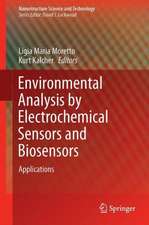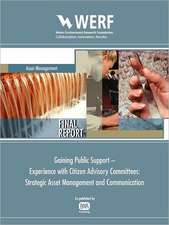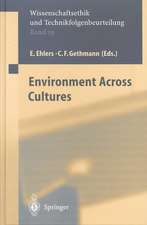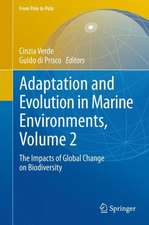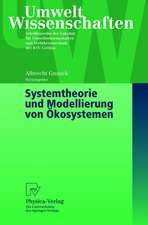Agricultural Implications of the Fukushima Nuclear Accident
Editat de Tomoko M. Nakanishi, Keitaro Tanoien Limba Engleză Hardback – 28 mar 2013
| Toate formatele și edițiile | Preț | Express |
|---|---|---|
| Paperback (2) | 359.79 lei 38-44 zile | |
| Springer – 23 aug 2016 | 359.79 lei 38-44 zile | |
| Springer – 25 apr 2018 | 365.99 lei 38-44 zile | |
| Hardback (2) | 427.07 lei 43-57 zile | |
| Springer – 18 mar 2016 | 432.51 lei 22-36 zile | |
| Springer – 28 mar 2013 | 427.07 lei 43-57 zile |
Preț: 427.07 lei
Nou
Puncte Express: 641
Preț estimativ în valută:
81.73€ • 85.01$ • 67.47£
81.73€ • 85.01$ • 67.47£
Carte tipărită la comandă
Livrare economică 14-28 aprilie
Preluare comenzi: 021 569.72.76
Specificații
ISBN-13: 9784431543275
ISBN-10: 4431543279
Pagini: 216
Ilustrații: X, 204 p. 96 illus., 69 illus. in color.
Dimensiuni: 155 x 235 x 17 mm
Greutate: 0.56 kg
Ediția:2013
Editura: Springer
Colecția Springer
Locul publicării:Tokyo, Japan
ISBN-10: 4431543279
Pagini: 216
Ilustrații: X, 204 p. 96 illus., 69 illus. in color.
Dimensiuni: 155 x 235 x 17 mm
Greutate: 0.56 kg
Ediția:2013
Editura: Springer
Colecția Springer
Locul publicării:Tokyo, Japan
Public țintă
ResearchCuprins
1. The overview of our research (Tomoko M. Nakanishi).- 2. Behavior of radiocesium adsorbed by the leaves and stems of wheat plant during the first year after the Fukushima Daiichi nuclear power plant accident (K. Tanoi).- 3. Radiocesium Absorption by Rice in Paddy Field Ecosystems (K. Nemoto and J. Abe).- 4. Cesium uptake in rice: possible transporter, distribution and variation (T. Fujiwara).- 5. Time-course Analysis of Radiocesium Uptake and Translocation in Rice by Radioisotope Imaging (N. I. Kobayashi).- 6. Vertical migration of Radiocesium fallout in soil in Fukushima (S. Shiozawa).- 7. Radioactive Nuclides in Vegetables and Soil Resulting from Low-Level Radioactive Fallout after the Fukushima Daiichi Nuclear Power Plant Accident: Case Studies in Tokyo and Fukushima (S. Oshita).- 8. Radioactivity in agricultural products in Fukushima (N. Nihei).- 9. Changes in the transfer of fallout radiocesium from pasture harvested in Ibaraki Prefecture, Japan, to cow milk two months after theFukushima Daiichi nuclear power plant accident (N. Manabe, T. Takahashi, J.-Y. Li, K. Tanoi, and T. M. Nakanishi).- 10. Radiocesium contamination of marine fish muscle and its effective elimination (S. Watabe, H. Ushio, D. Ikeda).- 11. Excretion of cesium through potassium transport pathway in the gills of a marine teleosts (T. Kaneko, F. Furukawa and S. Watanabe).- 12. Contamination of wild animals: Effects on wildlife on high radioactivity areas of the agricultural and forest landscape (K. Ishida).- 13. Remediation of paddy soil contaminated by radiocesium in Iitate Village in Fukushima Prefecture (M. Mizoguchi).- 14. Distribution of radiocesium from the radioactive fallout in fruit trees (D. Takata).- 15. Mushrooms¬: Radioactive Contamination of Widespread Mushrooms in Japan (T. Yamada).- 16. Diffusion and transportation dynamics of 137Cs deposited on the forested area in Fukushima after the Fukushima Daiichi nuclear power plant accident in March 2011 (N. Ohte, M. Murakami, T. Suzuki, K. Iseda, K. Tanoi, and N. Ishii).- 17. Developing an information package of radiation risk in beef after Fukushima Daiichi nuclear power plant accident (H. Hosono).
Textul de pe ultima copertă
Following the Fukushima nuclear accident, a large volume of monitoring data has been collected about the soil, air, dust, and seawater, along with data about an immense number of foods supplied to the market. Little is known, however, about the effect of radioactive fallout on agriculture, information about which is vital. Although more than 80% of the damaged area is related to agriculture, in situ information specifically for agriculture is scarce. This book provides data about the actual movement and accumulation of radioactivity in the ecological system—for example, whether debris deposited on mountains can be a cause of secondary contamination, under what conditions plants accumulate radioactive cesium in their edible parts, and how radioactivity is transferred from hay to milk. Because agriculture is so closely related to nature, many specialists with different areas of expertise must be involved in answering these questions. In the case of rice, researchers in rice cultivation as well as in soil, hydrology, and radioactivity measurement are working together to reveal the paths or accumulation of radioactivity in the field. For this purpose, the Graduate School of Agricultural and Life Sciences of The University of Tokyo has diverse facilities available throughout Japan, including farmlands, forests, and meadowlands. Many academic staff members have formed groups to conduct on-site research, with more than 40 volunteers participating. This book presents the data collected from the only project being systematically carried out across Japan after the Fukushima accident.
Caracteristici
Congratulations! Your book has achieved more than 100,000 downloads! Provides a quick grasp of the extent of the Fukushima accident’s effect on agriculture Details the movement of radioactivity during a one-and-a-half-year period All data are original, collected in situ Includes supplementary material: sn.pub/extras
Recenzii
“Nakanishi and Tanoi (both, Univ. of Tokyo, Japan) have compiled a series of open access papers detailing research from the first four years after the Fukushima nuclear accident. … the work provides clear insight into expectations from nuclear catastrophe, particularly within the framework of regulatory limits on radiation. … this source will prove useful to those living near nuclear reactors. Summing Up: Recommended. Undergraduates through professionals and practitioners.” (M. S. Coyne, Choice, Vol. 54 (2), October, 2016)


